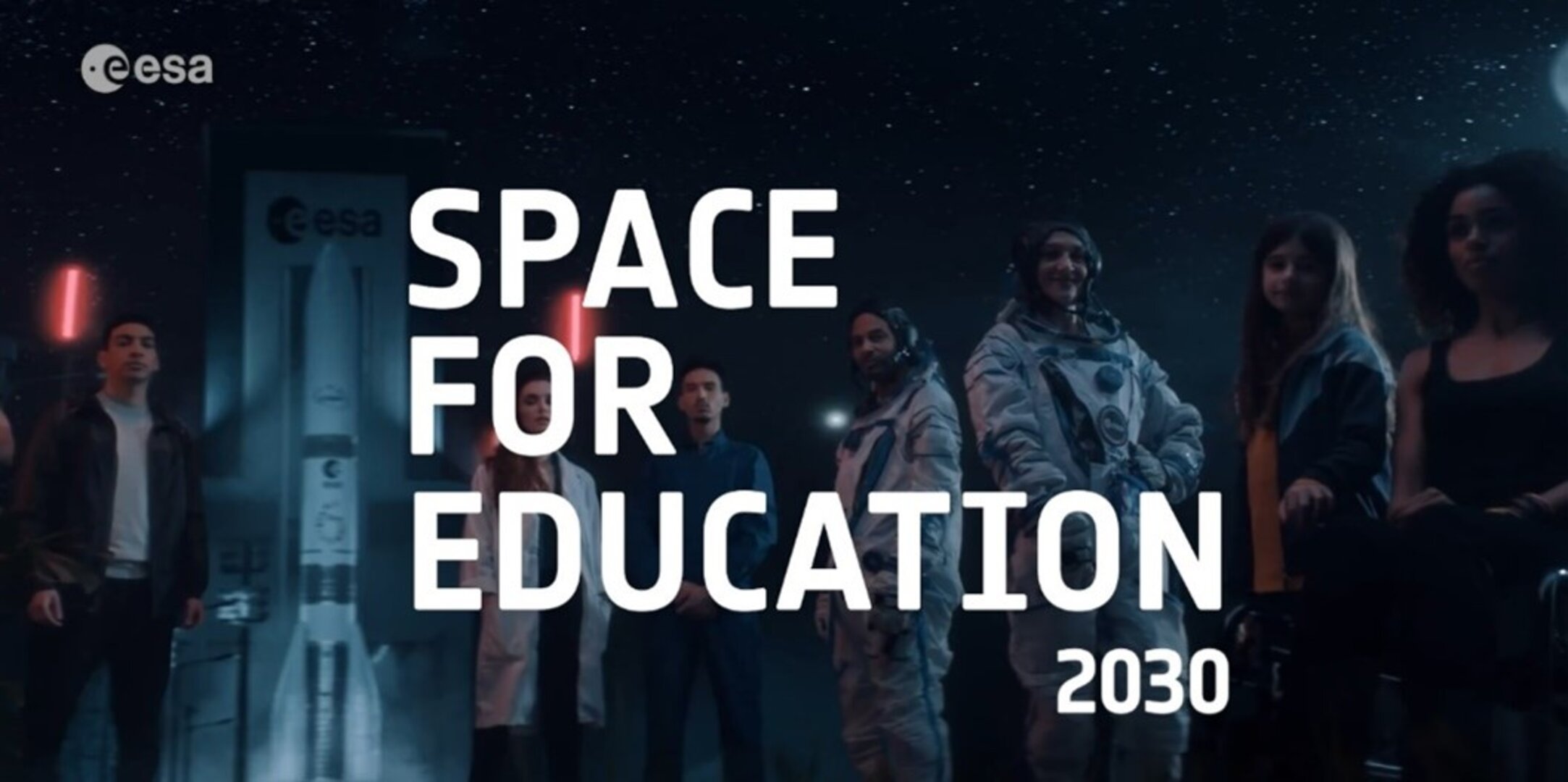With space at the forefront of education
The ESA Education Programme uses the fascination and the incredible knowledge generated by Europe’s unique space programme for the education and the benefit of the younger generation - from early age to early professional levels - and for the growth of society at large. Now, with the Space for Education 2030 vision, education at ESA is set on a fast track to the future.


Access the video
The ESA Education Programme is a so-called mandatory activity in the ESA Convention. For ESA, Education is fundamental not only to prepare the future workforce that will turn Europe’s space strategy and ambitions into reality, but also because it helps building generations of future citizens who are informed, able to decide and to act responsibly, and who are equipped to face the societal and global challenges of the future, whatever profession they choose.
At ESA we use space as a great asset in support of STEM (Science Technology, Engineering and Mathematics) education. Space is a modern myth, it is a large part of contemporary culture, it is a strong societal and economic driver and enabler, and much more. Learning by using space means accessing top-edge knowledge, learning to collaborate, create, innovate. In other words, learning by using space means being accompanied on an inspired, unique path to developing the so called 21st century skills – that is everything that any young person should be given the possibility to develop in order to be successful in a career and to contribute to a better future.
Today, more than ever, the key role of inspired education is a fundamental part of the ESA strategic vision for the future of Europe in space – Agenda 2025 – and one of the key means to make it a reality.
In December 2022 the ESA Member States officially approved the Space for Education 2030 (S4E 2030) vision and plan, giving their green light for the ESA Education Programme to go wider, more innovative, more inspirational, and reaching much farther than before.
Our mission

Space for Education 2030 (S4E 2030) is the long-term vision and plan for the ESA Education Programme, aligned with the strategy and ambitions for Europe in space set by ESA’s Agenda 2025.
With S4E 2030 ESA puts itself at the forefront of innovation in education, to achieve capacity building for the evolving space sector and for a sustainable society, and to help the young generation be ready “for jobs that have not been created, for technologies that have not yet been invented, to solve problems that have not yet been anticipated. [OECD, 2018]”
We will achieve these objectives by building on the successes and best practices from the existing education programme, but we will enlarge its scope and scale. Didactics innovation will be further pursued. New subject knowledge such as artificial intelligence, quantum technologies, and more will be covered, and with them we will reach additional target audiences. Interdisciplinarity and 21st century skills, so much needed by today’s labour market, will be systematically addressed, and all will be tapping from the whole range of space disciplines and their so called ‘downstream’ applications for the benefit of society. Last but not least, we will push on the inspiration accelerator as never before.
What’s in Space for Education 2030?
Space for Education 2030 targets a very wide age spectrum, from early ages up to the very first career stages, through two main pillars of unique activities:

the STEM Learning and Inspiration programme, for the education and inspiration of 3-18 years-old children and pupils, both directly and through their educators.

the new ESA Academy programme, for the skill-building and engagement of students in higher education.
3-18 y/o: STEM Learning and Inspiration programme
The new STEM Learning and Inspiration programme consists of two activity sets. The first one – Learn with Space – is strictly educational, with activities designed with specific learning objectives in mind, both for youngsters and their educators. The second – Let Space Inspire You – is strictly inspirational; it is aimed at using the ‘wow’ factor generated by space to spark children and teenagers’ curiosity and imagination, and to stimulate their interests towards STEM and space studies and careers. Whenever possible, synergy of activities within the two sets is pursued, so to mutually reinforce the learning and inspirational elements of the experience proposed.
All these activities are solidly rooted and implemented at national level through the ESA ESERO framework project, a network of dedicated national offices and consortia of partners established by ESA in its Member and Associate States.
In a nutshell:
- Learn with Space is a vast portfolio of initiatives to support educators from formal and non-formal education venues, starting from early-ages up to upper secondary age-groups. Such activities primarily consist of professional educator training, didactics resources, interdisciplinary school projects, thematic workshops and hackathons, and an international community of practice, all connecting the national and international dimensions together by building on the best from both experiences to boost STEM education at large.
- Let Space Inspire You is a large variety of inspirational and engaging events, role modelling, career awareness initiatives, and access to space experts – astronauts included – for youth and their families to share the fascination and importance of space and STEM; in doing so, help to break diversity barriers, boost accessibility, and promote sustainability for a better future.
18+ y/o: new ESA Academy programme
The new ESA Academy programme,run in collaboration with industry, academia and other stakeholders, is structured in three activity sets, which offer a broad variety of individual and team opportunities for university students and students in vocational training – in the future the target will be expanded to early-career professionals. The programme, is enriched to further prepare future talents to become successful professionals also beyond the space and science/technology sectors. With our portfolio, young adults are also becoming better equipped to play their role in addressing global and societal challenges, and get an opportunity to engage and connect with professional communities as early as possible along the path to their career.
In a nutshell:
- The ESA Academy Training programme offers a rich portfolio of highly qualifying training sessions, both online and onsite, covering a large range of topics offered by professional experts. Our objective is to complement the curricula of participants, including from non-space and non-STEM backgrounds, and better prepare them for a career which is either directly related to space, or that can benefit from the application of space assets.
- ESA Academy Projects include a wide number of hands-on projects, some upgraded and some newly introduced. Such projects make use of several experiment platforms, based on ground or in space such as CubeSats. Here we use project-based learning to complement the participants’ knowledge and practical experience, all in an international and interdisciplinary context, while adding new learning subjects to our portfolio, such as product development, entrepreneurship, innovation, and downstream space applications.
- The ESA Academy Engagement programme fosters structured collaboration within ESA and with external partners such as academia, industry, and institutions to contribute together to the preparation of the future talents. It encompasses funding opportunities, joint learning activities and mechanisms to offer access to ESA expertise. The Engagement initiative comprises elements that are transversal to all age groups, with a focus on inspiration, role modelling, career awareness and STEM promotion. In addition, some elements are specifically designed for university students, such as scholarships for external training and Master programmes, support for internships, conference opportunities, and collaboration on ESA Academy activities.














 Germany
Germany
 Austria
Austria
 Belgium
Belgium
 Denmark
Denmark
 Spain
Spain
 Estonia
Estonia
 Finland
Finland
 France
France
 Greece
Greece
 Hungary
Hungary
 Ireland
Ireland
 Italy
Italy
 Luxembourg
Luxembourg
 Norway
Norway
 The Netherlands
The Netherlands
 Poland
Poland
 Portugal
Portugal
 Czechia
Czechia
 Romania
Romania
 United Kingdom
United Kingdom
 Slovenia
Slovenia
 Sweden
Sweden
 Switzerland
Switzerland

























